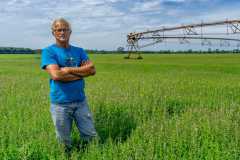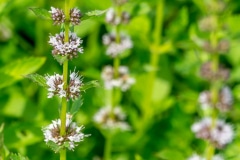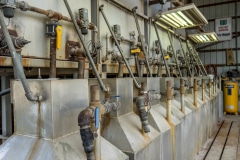
Oil in small glands on the back of the mint leaves is what Larry Wappel Sr. is after when he begins harvesting. The season starts in mid-July and runs usually until mid-September. At the 9,000-plus acre Wappel Grain & Herb operation, more than 1,000 acres are devoted to mint, and of that 90 percent of crop is peppermint and 10 percent is spearmint. Wappel, his wife Debbie and the couple's sons Larry Jr. and Eric all help run the family farm in northwest Indiana. Photo by Lisa Renze-Rhodes
Scenes From The Indiana Mint Harvest
Dirt deeply embedded into the swirls and callouses on Larry Wappel Sr.’s palms could almost be mistaken for tattoos. The seemingly permanent coloring is the result of a lifetime spent working with his hands on a farm that started with his father and will one day end up with his sons.
Keeping the land alive long enough for it to become trigenerational is as much a choice for Wappel as blinking would be. It’s why the more than 9,000-acre operation is robustly diverse, mindful of ever-changing markets and a critical need for self-sufficiency. Corn stalks wave in the wind within view of solar panels that help power the farm. Flowers planted at the base of those panels attract pollinators that fertilize the cucumber plants.

Larry Wappel Sr. started farming with his father and works today to ensure the now 9,000-acre Wappel Grain & Herb operation in San Pierre, Indiana, continues to thrive for the third- and fourth-generation farmers coming behind him. Part of the family’s secret to success is expansive crop diversification, like mint farming, and self-sustainability efforts including a small solar panel field. Wappel, his wife Debbie and the couple’s sons Larry Jr. and Eric all help run the family farm in northwest Indiana.Photo by Lisa Renze-Rhodes
And in several fields sit crops Wappel can hardly smell anymore. The plants rise to Wappel’s knees, their tiny white flower buds telling him all he needs to know—it’s mint harvesting time.
“I used to be able to smell it the way other people do,” Wappel says, as he walks a few feet into a field, reaches down and rubs his thumb across the back of some leaves, opening the oil pores and releasing a scent so strong it’s almost visible.
“Now if I get right on top of it, I can smell it.”
Wappel, his wife Debbie and sons Larry Jr. and Eric, along with a few other full-time farm hands, are part of a small, specialty group of mint producers in only six states who provide product that eventually finds its way into everything from Colgate toothpaste to Nestle foods.

After more than 30 years of farming mint, Larry Wappel Sr. can’t smell it as well as he used to. So one sure way to know that the mint hay is ready to harvest is the appearance of the small white buds on the plants that can tell Wappel what his nose can’t. The mint hay has to dry in the sun for at least a day and sometimes two before the oil can be extracted from the leaves. Wappel, his wife Debbie and the couple’s sons Larry Jr. and Eric all help run the family farm in northwest Indiana.Photo by Lisa Renze-Rhodes
In northwest Indiana, where the family farms, harvesting starts on their 1,200 acres of mint in mid-July and continues to mid-September. In all, Indiana growers harvested just slightly more than 10,000 acres of mint last year, according to the USDA.
It’s hard work that during the harvest keeps the team running until around 1 or 2 a.m., stopping down for a few hours’ sleep, then starting all over again.
“We don’t run 24 hours,” Wappel says quickly, though the unspoken remainder of that statement is that at the height of the season, it most assuredly feels like they do.
As he watches a red storm blob move across a radar app on his phone, Wappel explains how the harvesting works. It starts, not surprisingly, with the weather.
“We’ve got to be very careful when we cut it, ”Wappel says. The mint hay, as it’s called, has to dry naturally, at least for a day and sometimes two in the sun. Wet weather can cause the hay to rot on the ground, which renders the cut crop unusable.

Solar panels take up three-quarters of an acre of land at Wappel Grain & Herb in San Pierre, Indiana. The family opted to install the panels to further their sustainability efforts for not only their own farm, but in service to the larger community. Larry Wappel Sr., his wife Debbie and the couple’s sons Larry Jr. and Eric run the 9,000-plus acre operation in northwest Indiana.Photo by Lisa Renze-Rhodes
Then begins the process of actually extracting the mint oil.
“It’s on the underside of the leaves,” Wappel says, “in tiny microscopic glands.” He rubs a leaf and the scent drifts up and hangs in the air for a bit. “The oil is what we’re after.”
Once dry, the leaves are chopped and dumped into what Wappel describes as “giant pressure cookers,” then pressurized, with 350-degree steam rupturing the glands and vaporizing the mint oil. That vapor is collected and run through condensers that cool it, returning it to a liquid form. That oil ends up in 55-gallon drums, and that’s what goes to market via a broker of sorts connecting the supplier with producers that turn the mint oil into all kinds of household and other products.
If you brushed your teeth today, he says, the Wappel Grain and Herb mint could be in your home right now.
The move to mint for the family started more than three decades ago, at a time when there were hundreds of producers across the country. Now, Wappel says, those numbers have dropped to fewer than two dozen. But quitting has never been an option for the Wappels—it’s in their blood.

A stack of clean 55-gallon drums rest outside the distillery where the Wappel family extracts the oil from the mint hay they harvest. One drum of oil supplies enough mint for more than 400,000 tubes of toothpaste. Larry Wappel Sr., his wife Debbie and the couple’s sons Larry Jr. and Eric run Wappel Grain & Herb in San Pierre, Indiana, a 9,000-plus acre farm operation in northwest Indiana.Photo by Lisa Renze-Rhodes
There was a time when Wappel Sr., thought about studying engineering, but the pull of the farm was too strong to deny. Still, it would be hard to argue that he’s not an engineer, a chemist, architect, teacher — name the profession and Wappel can probably dip into it—but most certainly engineering. In addition to keeping a 40-plus year old boiler running (it had been part of a unit torn out of a hospital years ago), Wappel and his team maintain their solar panels, and an intricate irrigation system that improves operations across the farm.
The innovations and additions are part of a long-term commitment to sustainability that benefits their family, but also provides educational opportunity for visitors, including a contingent of international guests who visited last year.
But even that outreach is part of the family commitment to sustainability—what they consider to be a moral and ethical commitment to the land, their community and to one another.
“They really have no choice but to farm,” Debbie Wappel says. “It’s a God-given passion. They work day and night.
“They want to make a living but it’s so much more than that.”














